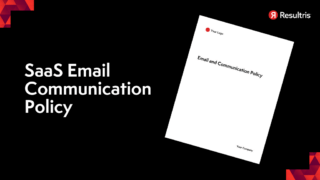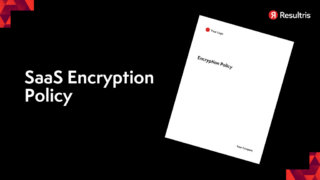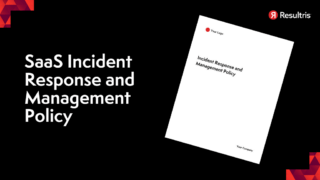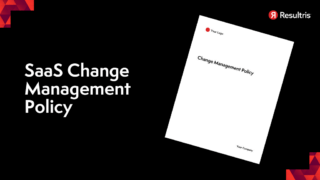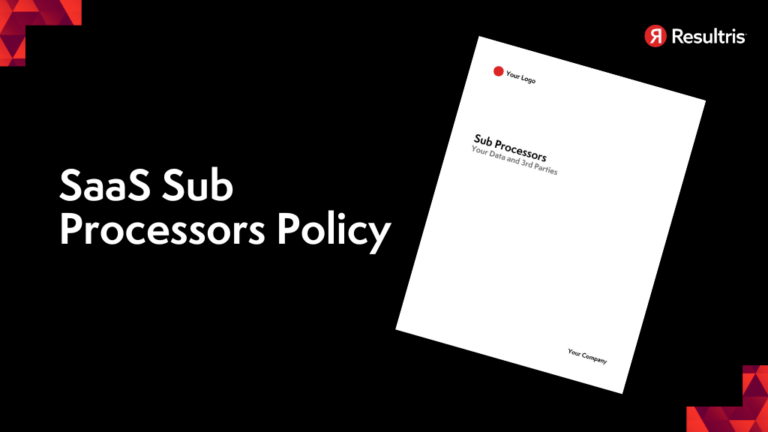
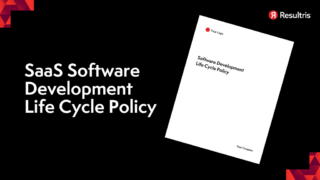
Written by: Tim Eisenhauer
Last updated:

Navigating the Software-as-a-Service (SaaS) world can often feel like walking through a maze. With its complex jargon and intricate policies, it’s easy to lose your way. One crucial area you can’t afford to overlook is the SaaS Sub Processors Policy.
This policy plays a pivotal role in your company’s data protection strategy. But what exactly does it entail? And how does it tie into SaaS Compliance and Security Best Practices?
In this article, we’ll demystify these questions, providing a clear roadmap to help you confidently navigate the SaaS landscape. We’ll explore the importance of the SaaS Sub Processors Policy, its implications for your business, and how it fits into the broader picture of SaaS security. Buckle up, it’s going to be an enlightening ride.
Digging deeper into the SaaS landscape, let’s shift focus towards the crux, the SaaS Sub Processors policy. It’s a pivotal component for businesses dealing with data protection and security within the SaaS ecosystem.
A SaaS Sub Processor is an entity or a third-party service provider engaged by a SaaS company to process customer data. The policy governing these Sub Processors, understandably named the SaaS Sub Processors policy, outlines the rules for handling of data. It’s more than just a policy document; it’s a tool for transparency, securing client trust, and ensuring data protection.
In the SaaS ecosystem, this policy plays a vital role. It doesn’t just comply with legal requirements, it fosters trust between clients and vendors. It detailly traces the customer data journey – where it’s held, who’s handling it, and how it’s protected. Think of it as a safety-proof layer in your data protection strategy.
Under the GDPR, it’s clear as day that businesses must maintain responsibility for customer data, even when employing Sub Processors. If you’re a SaaS vendor, you aren’t just bound to respect client data; you’re also compelled to ensure your Sub Processors follow suit.
Apart from the GDPR, other regional regulations like the CCPA also stress the importance of a SaaS Sub Processors policy. These regulations underline the need for transparency and accountability when dealing with customer data.
Finally, let’s not forget the industry-specific compliance requirements, such as HIPAA for healthcare and PCI-DSS for credit card payments. These solidify the significance of having a robust SaaS Sub Processor policy to meet statutory and regulatory requirements.
Following a concrete SaaS Sub Processors Policy fosters trust and regulatory compliance. Crucial constituents in this policy proposal include recognizing and classifying Sub Processors, executing sound due diligence during selection, establishing contractual obligations and implementing robust Data Processing Agreements (DPAs).
Understanding who your Sub Processors are, in a profoundly intricate SaaS landscape, becomes crucial. It’s not just about names but dives deep into roles, responsibilities, and data handling capacities.
Broadly, two categories exist: Critical Sub Processors and Non-Critical Sub Processors. Critical Sub Processors play pivot roles in delivering services, e.g., Amazon AWS for data storage. Non-Critical Sub Processors, like Mailchimp for email marketing, add value but aren’t service crucial.
Differentiating between critical and non-critical Sub Processors brings clarity to business continuity procedures. It’s about gauging their role in the SaaS service cycle, coupled with an impact analysis of potential business disruptions.
Robust selection involves comprehensive due diligence. It includes evaluating Sub Processors for data management skills, examining their data protection practices, and cross-verification of compliance standards. Case in point: A Sub Processor who’s an ISO 27001 certified entity can offer enhanced data security assurances.
Contractual obligations underscore the importance of clean agreements with Sub Processors. The contracts set out the responsibilities and expectations, ensuring that both parties are clear on data security, privacy, reporting procedures, and accountability mechanisms.
At the heart of the SaaS Sub Processors Policy is the DPA. A DPA outlines how data processing needs to be handled, respects both GDPR and CCPA regulations, and ensures industry-specific standards compliance. It’s about legally binding Sub Processors to treat your data with utmost security and meticulousness.
Policies are roadmaps, guiding your course of action. Regarding your SaaS Sub Processors Policy, it’s crucial to develop a solid structure that’s built with rigidity and compliance in mind. Let’s delve into the specifics of fashioning such a policy.
Risk assessments become key when dealing with Sub Processors. Such assessments draw clear lines between secure data operations and potential data threats. Begin these assessments by identifying the data types being handled. For instance, consider payment card information, customer personal information, and business intellectual property.
Next, outline the potential threats to each data type. In the instance of payment card information, threats could include unauthorized access, data leaks, and fraudulent transactions.
Thirdly, gauge the impact of those threats realizing. A fraudulent transaction, for instance, could lead not only to monetary loss but also reputational damage.
Finally, evaluate the Sub Processor’s existing structures for data protection. For instance, does their infrastructure align with industry-specific data protection standards?
By giving each aspect its due consideration, you’ll have a solid risk assessment for your Sub Processor usage.
The choice of a Sub Processor is crucial, so you’d want to establish a thorough selection criterion. Begin by deciding which data protection standards the Sub Processor must adhere to. Additionally, consider the Sub Processor’s readiness to enter into Data Processing Agreements.
Audit track records of potential Sub Processors. A past of consistent data protection efforts makes a Sub Processor a more favorable choice. Equally important is their access to resources for managing data breaches, if and when they occur.
An approval process solidifies your selection criterion. It establishes definitive steps to help avoid non-compliant Sub Processors.
Key stages in an approval process may include a preliminary selection, a detailed assessment, and departmental approvals. In the detailed assessment stage, data protection standards, resource availability, and readiness to enter Data Processing Agreements become the primary focus.
The process concludes once the legal, security, and technical teams give their nods of approval.
Stagnancy isn’t a friend of progress, especially not in policy-making. Regular reviews and updates keep your policy relevant and compliant.
Periodic audit reviews provide insights on the Sub Processor’s current adherence to the policy requirements. Amendments may become necessary if any deviations or deficiencies are discovered during these reviews. Ensure any changes made align with relevant data protection laws and contractual obligations to maintain compliance.
Developing a cohesive and comprehensive SaaS Sub Processors Policy is an involved process but a necessary one. By implementing these practices, you stay a step ahead in data protection and compliance.
Crafting a comprehensive SaaS Sub Processors Policy forms an essential aspect of your business’s data protection strategy. At this point, we turn our attention to the crucial steps of deploying this policy within your organization.
With a continuously evolving SaaS landscape, it’s crucial that you keep an up-to-date register of your Sub Processors. This involves regular monitoring of their performance, data protection practices, and compliance with the criteria outlined in your policy.
Revisions to your Sub Processors list aren’t a solitary affair. They require a robust and swift mechanism to alert relevant stakeholders. Your notification process should be wide-ranging, covering various scenarios such as the addition of a new Sub Processor, alterations to an existing Sub Processor’s services, or termination of a Sub Processor.
Lastly, but no less importantly, customers form a significant aspect of your Sub Processors policy implementation. Given the core role they play in GDPR or CCPA compliance, transparent and proactive communication with customers cannot be overstated.
In essence, implementing your SaaS Sub Processors Policy isn’t merely a regulatory step. It’s an ongoing process that demands active participation, transparent communication, and regular updates. Together, these elements ensure that your organization remains both compliant and secure.
Journeying into the technical dimensions, we’re exploring the operational aspects of sub processor management. This section hones in on data flow mapping, access controls, data segregation, encryption, and data protection measures.
Mapping data flow with sub processors forms the backbone of efficient Sub Processor management. Think of it as a visual diary of your data’s journey, showcasing its interaction with various sub processors. It aids in locating the points of data transfer, allowing for precision in managing security risks.
Consider each data set in a SaaS setup, and identify its interaction points with sub processors. Necessitating a clear identification of each data route, this exercise paves the way for robust data security mechanisms.
Compartmentalization rings familiar in the realm of data management, and rightly so. With access controls and data segregation, you’re doing just that – dividing the data into distinct segments to secure information.
Access control mechanisms ensure only authorized entities have access to data. An accomplishment of this mechanism happens when you determine the degree of access granted to each entity, based on their role and necessity.
Meanwhile, data segregation works on the principle of ‘divide and rule.’ It involves clustering your data into various blocks, each managed and stored separately. It’s a strategic approach to limit the damage in case of a potential data breach.
Finally, let’s dive into how encryption works in ensuring data protection. Picture a secure locker safeguarding your data; encryption works similarly by converting data into a code to prevent unauthorized access.
Leveraging encryption measures, data stays protected even during transfers between different sub processors. It gives you control over both data in transit and at rest. Undoubtedly, it’s an invaluable ally in maintaining data security within the complicated network of SaaS sub processors.
In the vast landscape of Software-as-a-Service (SaaS), managing Sub Processors is not a one-time task. Optimal practices require continuous vigilance and stringent controls. This section will explain a few operational facets susceptible to attention: Ongoing Monitoring of Sub Processors, Audit and Compliance Verification, and Incident Response involving Sub Processors.
Ongoing monitoring of sub processors is not an option, it’s a necessity. Imagine running a ship without keeping an eye on its route. Similar to that, without monitoring, the processes might go off course. Appropriate monitoring protocols include routine checks, stipulated in the Data Processing Agreements (DPAs). These checks ensure sub processors’ adherence to data protection standards and their contractual obligations.
Transparency breeds trust, especially when it involves data protection. Audit and compliance verification serves as a double-check mechanism. Regular audits confirm the sub processors’ adherence to the stated regulations, such as GDPR and CCPA. Compliance verification solidifies the transparency factor, ensuring customers that their data is in reliable hands.
In the SaaS ecosystem, preparation for potential data incidents is as crucial as ongoing compliance. An efficient Incident Response Plan (IRP) involves swift actions, competent teams, and open communication channels with the affected parties. Not to mention, this IRP must extend to your sub processors. It’s important to remember, incident management is not just about rectifying errors; it’s about preserving trust and commitment to data protection.
Building customer trust links directly to being transparent about your SaaS Sub Processors policy. Success lies in clear communication and showing commitments to data protection.
When mentioning Sub Processors to your customers, it’s crucial to provide specific information. For example, detail the nature of the services performed by these Sub Processors, the entity’s name and location, and their role in processing customer data. By making this information available, customers get a clear picture of their data flow. Adopt a consistent routine for sharing updates about your Sub Processors list, proving your commitment to data transparency.
Customer inquiries are unavoidable, often, they come packed with concerns about data privacy. Those concerns can’t go unanswered. It’s essential to handle these inquiries promptly and professionally. For instance, set up a dedicated customer service or technical team to respond to such queries. Also, consider creating an FAQ resource on your website to address common questions, providing immediate ease to customer’s concerns.
Customers entrust their data to you. So, it’s your role to prove that their trust isn’t misplaced. Meaningful assurances on data protection can help you achieve this. Educational resources spread across your site act as a reliable source of information on data protection processes – like encryption measures, access controls, and incident response mechanisms. These resources not only inform but also demonstrate your commitment to preserving customer data, which in turn, boosts customer trust. Keep these assurances at the forefront and update them as regulations or practices evolve. Their significance can’t be overstated. Remember, staying transparent adds value to your customer trust.
The following clarifies your legal stance and identifies contractual aspects related to Sub Processors in a SaaS model.
As a SaaS provider, you bear responsibility for services delivered, even those outsourced to Sub Processors. Ideally, the Sub Processor agreement iterates duties, obligations, and a detailed liability clause. It’s beneficial, for example, to include an indemnification provision. In the event of data breaches or loss, the onus reverts to the Sub Processor, providing damage relief to the SaaS provider, given compliance with pre-decided guidelines was intact.
Your clients retain the right to object to specific Sub Processors, which must be clearly outlined in your agreements. Detail your notification process for changes in Sub Processors, preserving enough time for clients to assess the new entity. Define a process to handle objections, including alternate Sub Processor suggestions or even the provision for terminating the agreement in the objecting client’s favor, without punishing them with penalties or extra costs.
End-of-contract procedures attract a substantial section in Sub Processor contracts. Address the Sub Processor’s commitment to return or delete customers’ data accurately, post-contract. Be specific about the timeline, process, and proof of data deletion. Ensure your customer’s have the right to an independent audit verifying the effective and secure deletion of their data.
Navigating the complexities in SaaS sub processor management brings up unique challenges.
Unfolding technology advancements levitate substantial growth in cross-border data transfers, adding another facet to SaaS sub processor management. Mapping the data flow from one legal jurisdiction to another distinguishes a critical aspect. As data travels, it gets subjected to various international laws. For instance, the General Data Protection Regulation (GDPR) governs data transfers in the European Union, and the California Consumer Privacy Act (CCPA) dictates those in California. Understanding these regulations, ensuring they’re respected by all sub processors, and confirming that adequate safeguards are implemented can be quite daunting.
A major challenge resides in upholding vendor relationships while ensuring strict compliance with regulatory norms. SaaS providers depend on sub processors for various aspects like cloud storage, customer support, and analytics. However, regularly monitoring these sub processors’ data handling methods, their compliance with contractual obligations, and executing audits require significant organizational effort and resources. It’s no easy task to maintain a robust relationship with vendors while enforcing stringent data privacy rules.
Lastly, dealing with customer apprehensions regarding sub processors proves to be testing. Clients want assurance of secure data handling by sub processors and clear notification processes regarding the use of their data. Ensuring transparency, allowing clients the right to object to specific sub processors, and maintaining a smooth termination procedure including data return/deletion protocols can be a strenuous task. Trust-building becomes crucial in placating customers and showcasing how diligently the SaaS provider manages its sub processors.
These challenges contribute to the intricate and dynamic realm of SaaS sub processor management. Yet, overcoming these paves the way for fortified relationships, increased trust, and reinforced regulatory compliance.
You’ve got the ball rolling with your SaaS Sub Processors Policies. It’s now important to address certain practices to reinforce your commitment to transparency, trust, and regulatory compliance.
Regular audits establish a line of defense, verifying the mentioned standards by your Sub Processors. These audits ascertain the effectiveness of established data protection measures. They, for instance, test controls for access and encryption. Think audits as a robust mechanism to ensure continuous compliance, curb risks, and enhance trust.
You also don’t stop at conducting audits. Analyze audit reports, understand findings, and identify areas for improvement. Communicate these insights to your Sub Processors and work collaboratively to strengthen compliances. Most importantly, maintain a record of these audits. Future audits can reference previous ones, observing progress and identifying recurring compliance issues.
As the next step, work towards standardizing Sub Processor Agreements. Every Sub Processor you engage introduces unique challenges, but the core requirements remain consistent. Here’s where standardization steps in!
A standardized agreement reduces complexities, provides a level of predictability, and ensures consistency between agreements. Your key components – like due diligence, contractual obligations, and Data Processing Agreements (DPAs) – can be your yardsticks here. Strive towards creating a blueprint, considering these components to promote uniformity, clarity, and comprehension.
The third practice cannot be overstated – fostering a culture of data protection. It’s not about stringent guidelines or severe penalties. It’s about fostering an environment where data protection becomes inherent, a reflex even.
Leverage your Sub Processor relationships to drive this culture. Educate them about the importance of data security, the risks, and consequences of breaches. Encourage them to adopt best practices, and recognize their efforts towards maintaining compliance.
While these practices might appear daunting at first, pursuing them with diligence results in numerous benefits. You alleviate risks, build trust with your customers, reinforce your relationships with Sub Processors, and most importantly, stay on the right side of regulatory compliance. And remember, maintaining a comprehensive SaaS Sub Processor Policy isn’t just an option for a business in the 21st century – it’s an absolute imperative.
Effectiveness reflects the impact of your SaaS Sub Processors Policy in achieving goals such as regulatory compliance, data security, and customer trust. Evaluating effectiveness requires attention to Key Performance Indicators, compliance metrics, and customer feedback, among other elements.
KPIs provide objective measures of your Sub Processor Policy’s success. These might include the frequency of policy violations, the time taken to onboard new Sub Processors, or satisfaction scores from internal stakeholders.
For example, if routine audits reveal repeated issues identical to those identified previously, addressing underlying root causes becomes a clear objective. Another critical KPI might be the speed of response to data breaches. Rapid reaction times – ideally within 24 hours – indicate a responsive, robust system ready to take corrective action if breaches occur.
Compliance metrics provide tangible evidence of adherence to industry regulations – GDPR, CCPA, or otherwise. For instance, you might monitor the number of successful audits or the percentage of data requests successfully processed within stipulated timeframes.
Organizations must also regularly report on these metrics. Quarterly reports, for instance, provide a routine opportunity to check in on progress and make any necessary adjustments. The information contained in these reports becomes especially valuable during regulatory audits, illustrating commitment to maintaining high data protection standards.
Customer satisfaction becomes a powerful measure of Sub Processor Policy effectiveness. Soliciting customer feedback, specifically about their satisfaction with Sub Processor Transparency, can help in tweaking communication strategies and in disclosing related information.
For example, if customers indicate they value knowing about the data protection measures in place or express a need for regular updates on the subject, you can integrate those preferences into your customer engagement strategy.
Remember, a successful Sub Processors Policy isn’t stagnant. Continually measuring and improving upon these aspects remains key to maintaining a robust, effective system that serves both your organization and its customers.
In the SaaS industry, it’s essential to stay updated with the newest trends in Sub Processor management. Advancements in technology continually redefine Sub Processor relationships, risk management, and compliance protocols.
Embracing AI and automation has become increasingly prevalent in vendor risk management. AI technology isn’t just transformative; it’s revolutionizing the way we assess and manage risks. For example, predictive algorithms help identify potential data breaches before they occur, reducing the overall exposure to risks.
All types, whether you’re dealing with first, second, or nth-tier Sub Processors, Software tools powered by AI automate tasks such as due diligence and ongoing monitoring. By automating these tasks, you eliminate human error and bolster efficiency.
Traditionally, tracking Sub Processor compliance has proven to be a difficult task. However, blockchain technology, most commonly associated with cryptocurrencies like Bitcoin, offers a promising solution.
Blockchain’s inherent transparency and decentralization make tracking and recording Sub Processor activities secure and straightforward. Each transaction or update is recorded and time-stamped, creating an unalterable audit trail that facilitates compliance monitoring.
Edge computing, a rising trend in data processing, also impacts Sub Processor relationships. In contrast to traditional methods, where data is processed in a centralized location, edge computing processes data near its source.
After delving into the nuances of SaaS Sub Processors Policy, let’s pivot to managing dynamic situations. Here, you’ll explore scenarios such as unforeseen service provider changes, multi-cloud ecosystems, and security breaches involving Sub Processors.
Imagine a crucial service provider announces a significant operational shift. This might result from corporate restructuring, merger, or even bankruptcy. In such cases, prioritizing a robust transition strategy becomes critical.
Review existing contracts, focusing specifically on change of control clauses. Accurate contingency planning pivots around these provisions. Additionally, take advantage of the situation to renegotiate terms or seek better alternatives.
Don’t forget to notify affected stakeholders promptly. Communication helps manage expectations, round off edges and makes the transition smoother.
Stewarding SaaS applications across multiple cloud platforms gives a strategic edge. But, it invites unique challenges in Sub Processor management.
Increase synchronization across platforms. A solution harmonizing utilization information, permissions, and updates ensures efficient operations. Moreover, consider standardizing protocols. You’d experience less friction in coordinating Sub Processor activities across different infrastructures.
It’s also essential to map out data flows meticulously. As you juggle between clouds, consolidating this information prevents leaks, enhances security, and optimizes storage allocation.
Breeches might be inevitable, but recovery isn’t. Facing a security incident involving a Sub Processor can be daunting, but a concrete action plan can turn the tide in your favor.
Initially, identifying the breach and limiting its impact is crucial. Involving cybersecurity experts can expedite this. Once containment is achieved, investigate the breach source and address it. Facilitating this usually involves a shared responsibility with the Sub Processor.
Next, is notifying the relevant people. Remember, regulatory entities might need to be at the forefront of this list. Following this should be a thorough review. This could prevent a recurrence by shedding light on gaps in your defense strategy.
As you venture deeper into the SaaS realm, innovation and compliance form the crux of your journey. The challenge lies in leveraging emerging technologies while keeping in line with solid Sub Processor Policy.
In this fast-paced SaaS landscape, it’s critical to stay ahead. New technologies pose exciting opportunities to streamline Sub Processor management. When considering these technologies, focus on their compatibility with existing systems, data protection features, and meeting baseline compliance requirements. For instance, a blockchain-based compliance tracker promises improved transparency, but it’s paramount it doesn’t disrupt your existing data flow.
Sub Processor management, it’s a constant balancing act. Agility here refers to your ability to promptly respond to changes – be it onboarding a new Sub Processor or transitioning to different platforms. For example, an urgent switch to a multi-cloud environment tests your strategic planning skills and your preparedness to adapt while maintaining regulatory compliance.
The crux of it all? Your Sub Processor Policy ought not to be a standalone document. It’s an intrinsic part of your overarching business strategy. From the degree of decentralization in data processing to your plan to manage a potential security breach, these aspects interlink with broader organizational goals. Let’s consider edge computing; it shifts data processing towards the source, which could speed up operations; however, the question remains: How well does it align with your data security structures? Always keep the bigger picture in view, focused on the harmony of innovation and compliance.
A holistic understanding of sub processors plays a pivotal role in SaaS operations. Let’s cover some key elements that constitute part of customer education to make complex concepts more digestible.
A sub processor, technically, is a third-party entity engaged by a data processor to assist in fulfilling contractual obligations. Primarily, sub processors perform tasks related to the handling, processing, or storing of personal data. It’s crucial to remember that while sub processors can add immense value by bringing in specialized expertise, they also have to be managed effectively to ensure compliance with legal and regulatory requirements in data protection.
Customers often raise concerns about data privacy and security when dealing with sub processors. For example, they may question whether their personal data can be accessed without their knowledge or how they can have peace of mind about data safety with multiple entities involved. It’s important to shed light on these concerns by underlining robust internal controls, stringent vetting processes for sub processors, and contract clauses that ensure each party’s responsibilities and obligations are well-defined and enforced.
To ensure customers have access to more detailed information on managing sub processors, it can be helpful to provide additional resources. These may include links to authoritative websites, in-depth guides on relevant subjects, and resources on data protection and privacy regulations like GDPR and CCPA. Offering these resources fosters a learning environment for customers and aids in developing a better understanding of the SaaS sub processors policy. A well-informed customer base, after all, leads to better trust and stronger business relationships.
You’ve seen how a thorough SaaS Sub Processors Policy is key to building transparency and trust while meeting regulatory demands. It’s about more than just identifying Sub Processors and meeting contractual obligations. It’s about leveraging technology like AI, automation, and blockchain to keep up with compliance tracking. Edge computing’s impact on data processing can’t be ignored either. But don’t forget the human element. Educating your customers about Sub Processors, their role, and how to manage them effectively is just as crucial. As the SaaS landscape continues to evolve, it’s clear that strategic planning, agility, and alignment with your business strategy are essential. Balancing innovation with compliance isn’t easy, but it’s certainly achievable with the right approach.
Disclaimer
Please note that the information provided in this blog post is for informational purposes only and does not constitute legal advice. We are not lawyers, and reading this content does not create an attorney-client relationship. For legal advice specific to your situation, please consult with a qualified attorney.

